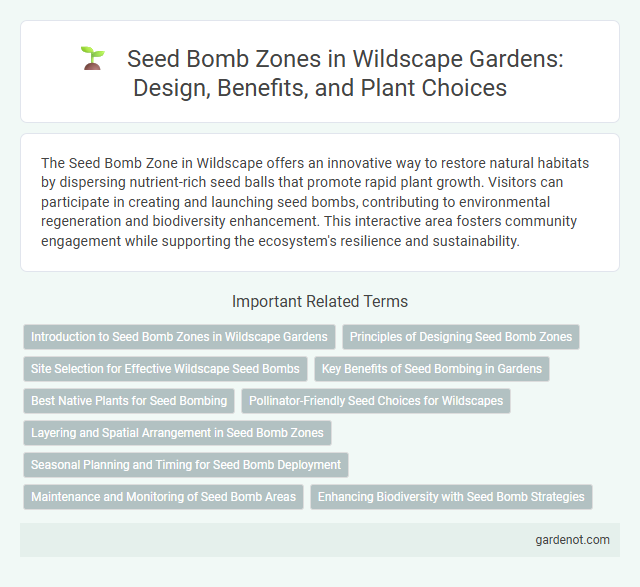The Seed Bomb Zone in Wildscape offers an innovative way to restore natural habitats by dispersing nutrient-rich seed balls that promote rapid plant growth. Visitors can participate in creating and launching seed bombs, contributing to environmental regeneration and biodiversity enhancement. This interactive area fosters community engagement while supporting the ecosystem's resilience and sustainability.
Introduction to Seed Bomb Zones in Wildscape Gardens
Seed Bomb Zones in Wildscape Gardens play a vital role in habitat restoration by dispersing nutrient-rich seed bombs that promote native plant growth. These zones create a fertile environment for wildflowers, grasses, and shrubs, fostering biodiversity and supporting pollinators like bees and butterflies. The strategic placement of seed bombs accelerates rewilding efforts, enhancing ecosystem resilience and natural regeneration.
Principles of Designing Seed Bomb Zones
Designing Seed Bomb Zones requires selecting diverse native plant species that thrive in the local ecosystem to maximize biodiversity and restoration success. Soil analysis ensures optimal seed germination and growth conditions, while site accessibility facilitates maintenance and monitoring. Integrating ecological principles with community involvement enhances habitat connectivity and promotes sustainable regeneration in Wildscape projects.
Site Selection for Effective Wildscape Seed Bombs
Selecting an optimal site for wildscape seed bombs requires analyzing soil quality, sunlight exposure, and existing native vegetation to ensure seed germination and plant biodiversity. Areas with minimal human disturbance and high ecological value, such as degraded urban parks or brownfields, promote successful habitat restoration and wildlife attraction. Prioritizing locations with suitable microclimates and connectivity to other green spaces maximizes seed dispersal and ecosystem integration.
Key Benefits of Seed Bombing in Gardens
Seed bombing revitalizes gardens by enhancing biodiversity, attracting pollinators like bees and butterflies essential for plant reproduction. It improves soil health through natural aeration and nutrient cycling, fostering resilient plant growth. This eco-friendly technique also reduces erosion, promotes native flora restoration, and supports local ecosystems' balance.
Best Native Plants for Seed Bombing
Best native plants for seed bombing in Wildscape's Seed Bomb Zone include milkweed, black-eyed Susan, and purple coneflower, all known for their resilience and ability to thrive in local soil and climate conditions. These species attract pollinators such as bees, butterflies, and birds, enhancing biodiversity and supporting ecosystem health. Using native plants ensures better germination rates and contributes to the restoration of natural habitats.
Pollinator-Friendly Seed Choices for Wildscapes
Selecting pollinator-friendly seed choices for wildscapes enhances biodiversity by attracting essential species like bees, butterflies, and hummingbirds. Incorporating native wildflowers such as Echinacea, Milkweed, and Black-eyed Susan creates a thriving seed bomb zone that supports pollination and ecosystem resilience. These seeds promote habitat restoration while providing year-round nectar and pollen sources vital for pollinator health and wildscape sustainability.
Layering and Spatial Arrangement in Seed Bomb Zones
Layering and spatial arrangement in Seed Bomb Zones enhance seed germination and plant growth by optimizing soil contact and moisture retention. Strategic placement of seed bombs in multiple layers ensures diverse vegetation establishment, supporting biodiversity and habitat complexity. Proper spatial distribution minimizes competition and fosters resilient plant communities within the Wildscape environment.
Seasonal Planning and Timing for Seed Bomb Deployment
Effective seed bomb deployment in the Wildscape Seed Bomb Zone depends on precise seasonal planning and timing to maximize germination success. Optimal periods align with early spring and late autumn when soil moisture is high and temperatures are moderate, fostering seedling establishment. Ignoring seasonal cycles increases seed failure rates, reducing vegetation recovery and biodiversity restoration efforts.
Maintenance and Monitoring of Seed Bomb Areas
Regular maintenance of seed bomb zones involves verifying soil moisture levels and removing invasive species to ensure optimal germination conditions. Continuous monitoring through drone imaging and on-site inspections tracks plant growth and biomass density, facilitating early detection of ecological imbalances. Implementing adaptive management strategies based on data analytics enhances biodiversity restoration and maximizes seed bomb efficacy in Wildscape projects.
Enhancing Biodiversity with Seed Bomb Strategies
Seed bomb zones serve as a dynamic method to enhance biodiversity by dispersing native plant seeds strategically across degraded landscapes. These seed bombs facilitate rapid germination and establish diverse plant species that attract pollinators, support wildlife habitats, and improve soil health. Integrating seed bomb techniques into wildscape management accelerates ecosystem restoration and promotes resilient, self-sustaining habitats.
Seed bomb zone Infographic

 gardenot.com
gardenot.com